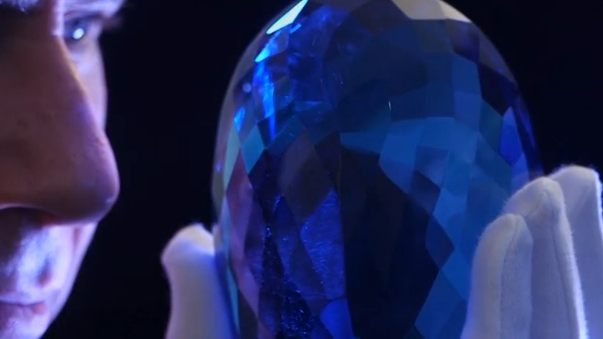
LONDON, England, UK (Reuters) — It’s said to be the largest blue topaz gemstone ever mined and glitters a vivid electric blue in the light.
Now it will be shown off to the world after three decades kept hidden away in a vault.
The Ostro stone is an oval 9,381 carat blue topaz, equivalent in weight to two kilos or two bags of sugar.
It’s being given on permanent loan to a London museum by the family of gemstone pioneer Max Ostro who discovered the giant stone in Brazil in 1986.
“What is amazing about this stone is not just its size, its.. its quality, the color, the intensity of the blue and the clarity of the stone are what makes it so exceptionally rare,” said Maurice Ostro, Chairman of Ostro Minerals and son of the man who discovered it.
The stone has been kept locked away for the past few decades, but after the passing of his father, Maurice decided everyone should enjoy its beauty for free.
It will be on permanent display in the prestigious Natural History Museum.
“I think it will tell us another bit of the natural story,” said Mike Rumsey, curator of the Minerals Gallery.
“You start off with a rough mineral, which is all kind of interesting and I really like that as a scientist. And then we do things to it, we’ll change it and we will cut it into something and this is really a fantastic example of the way in which we have crafted something out of nature,” he said, explaining how he hopes the Ostro stone’s carved and enhanced beauty will inspire visitors to learn more about rock formations.
The museum has had to put in extra security to house the blue topaz.
Neither the museum nor Ostro Minerals would put a price tag on the 15cm long, 10.5cm wide gem.
But for the family of Max Ostro, whose team battled piranhas and disease in the Amazon Rainforest to get the rare stone, it will never be for sale.
“My father actually did something quite remarkable in terms of developing the colored stone industry and that’s the story I’d like to share. People seeing the stone and the fruits of all his work is something that is very heart-warming to myself and my children and my whole family,” said Maurice Ostro.
The blue topaz will be on public view at the Natural History Museum from October 19.








